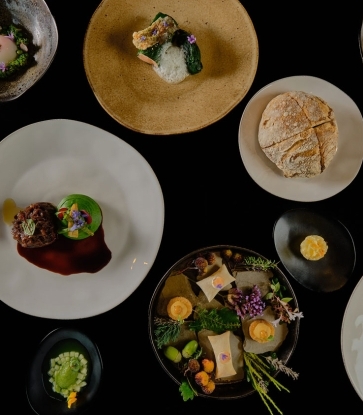Blood oranges are the culinary representation of the adage "don’t judge a book by its cover." While the name may inspire more dread than craving, don’t let the off-putting term fool you. Move past the macabre moniker and you’ll find a delicious citrus with a sweet orange flavor tinged with raspberry, and a flesh ranging in color from deep pink to its namesake blood red.
Available from December through April, blood oranges thrive in temperate climates. They are grown primarily in California, Florida, Italy and Spain's Mediterranean region; however, some sectors of Arizona and Texas produce them as well. Blood oranges are believed to have first been cultivated in Sicily as far back as the ninth century when only royalty had access to them. Sicilian leaders quickly recognized the fruit’s value and started exporting them to other countries. Today, they’re found on produce stands around the world.
Though their flesh grabs all of the attention, the skin of the blood orange also has distinct qualities that set it apart from other citrus. Sometimes boasting a reddish tint, it is knobby and thick, which makes it easy to peel. The reddish color is created by anthocyanin, a pigment created when citrus fruits are allowed to ripen in climates with hot days and cool nights. A powerful antioxidant, anthocyanin is also responsible for the bright color of blueberries, cranberries and other fruits boasting vivid hues. The pigment begins to develop at the peel, then moves through the perimeter of the orange segments before finally spreading into the flesh. Due to the pigment’s pattern of movement through the orange, it’s not uncommon to find blood oranges that are streaked rather than fully red.
There are numerous varieties of blood oranges but Moro, Ruby, Sanguinello and Tarocco are the most widely-available. Moro are most popular in the United States. They’re known for their bright orange skin and a flavor that is the perfect punchy blend of sweet and tart. Despite its name, the pigment in Ruby blood oranges creates a streaked pattern rather than the jewel tone its name implies. Sanguinello blood oranges, a smaller variety with little to no seeds, are most popular in Spain. Tarocco blood oranges have the least vibrant flesh color of these varieties, but their sweetness has made them highly favored in Italy, where they are the most desired.
Though blood oranges are often smaller than other oranges, they should feel weightier than they look. Select oranges that are firm and blemish-free. The flesh of blood oranges has fewer seeds and is sweeter than other varieties. Store blood oranges at room temperature and they’ll last several days. You can extend their shelf life for as long as two weeks by placing them in the refrigerator. Bring your oranges to room temperature before eating them to maximize their flavor.
Anthocyanin, the antioxidant that gives blood oranges their color, also gives the fruit a significant health boost, helping combat both heart disease and diabetes. Blood oranges are a rich source of vitamin C—one orange contains 130% of the daily recommended allowance. They are also low in calories and high in fiber and potassium.
When in season, freshly-squeezed blood orange juice is both beautiful and delicious. The oranges are often put to use in salads, salsas and jams, and as garnishes for all manner of dishes from ice cream to cheesecakes to cocktails. At Novela, a cocktail lounge in San Francisco, its menu of punches, which changes frequently, often features an intoxicating blend of blood orange, chai, strawberry and fresh tarragon. Diners lucky enough to enjoy a meal at Maison Yaki in Brooklyn can feast on scallops dressed with sauce Maltaise, a Hollandaise sauce made with blood orange juice. The chefs at MICHELIN-starred Bâtard in New York City serve a buttermilk panna cotta accented with a small dice of a lemon verbena syrup-soaked grapefruit and Cara Cara and blood oranges.
Blood oranges are a highlight of winter. Their brightness of color and flavor can elevate your plates and glasses, and are the perfect citrus solution to the winter doldrums.




















